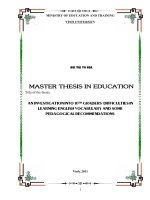Adaptive brake lights an investigation into their relative benefits in regards to road safety
Bạn đang xem bản rút gọn của tài liệu. Xem và tải ngay bản đầy đủ của tài liệu tại đây (2.17 MB, 157 trang )
Craig Roughan
BachBltEnv, GradDipIndDes
Principal Supervisor
Professor Vesna Popovic
Associate Supervisor
Associate Professor Andry Rakotonirainy
School of Design
Faculty of Built Environment and Engineering
Adaptive Brake Lights: an Investigation into their Relative
Benefits in regards to Road Safety
submitted for:
BN71 Masters of Applied Science by Research
January 2007
Keywords
Adaptive brake lights and interfaces, automotive design, brake light interface
user testing, driving simulator, human factors, in-vehicle intelligent transport
systems, road safety, transport design, variable brake lights.
i
ii
Abstract
The implementation of In-Vehicle Intelligent Transport Systems (ITS) is
becoming
a
common
occurrence
in
modern
vehicles.
Automobile
manufacturers are releasing vehicles with many forms of sophisticated
technologies that remove much of the responsibility of controlling an
automobile from the driver. These In-Vehicle Intelligent Transport Systems
have stemmed from a genuine need in regards to road safety, however there
are advantages and disadvantages associated with ITS. Each different form of
technology has its own inherent compromises in relation to road safety, driver
behaviour and driver comfort.
This thesis outlines the benefits and detrimental effects associated with
current In-Vehicle Intelligent Transport Systems and details the development
and user interface testing of an adaptive brake light. The adaptive brakelight
concept aims to provide drivers with the advantages of an In-Vehicle ITS
whilst removing the disadvantages. The technology will help drivers judge the
braking pattern of the car in front, thus allowing them to react appropriately
and potentially reducing the occurrence of rear-end crashes.
The adaptive brake light concept was tested in comparison to a standard
brake light and BMW inspired brake light in a series of user interface tests.
The adaptive brake light was shown overall to be an improved method of
displaying the varying levels of deceleration of a lead vehicle. Whilst different
age and gender groups responded differently to the adaptive brake light, it
was shown to be of benefit to the majority and the most at risk groups
responded positively to the adaptive brake light.
This research shows that an adaptive brake light can provide a benefit in
regards to road safety when compared to a standard brake light interface. It is
hoped that further development of variable brake lights will result from this
research and possibly lead to the implementation of the technology to
automobiles and other forms of transport.
iii
iv
Table of Contents
Keywords
Abstract
Table of Contents
Statement of Original Authorship
Acknowledgements
i
iii
v
ix
xi
1.0
1.1
1.2
1.3
Introduction
Research Question
Aims and Objectives
Structure of this thesis
1
2
2
3
2.0
2.1
2.2
2.3
2.4
2.5
2.6
2.7
2.8
2.9
2.10
Intelligent Transport Systems (ITS)
The Future of ITS
In-Vehicle Intelligent Transport Systems
Adaptive Cruise Control or Autonomous Intelligent Cruise Control
Active Steering
Collision and Accident Avoidance Systems
Collision Warning Systems
Navigation Systems
Head-Up Displays
Inter-Vehicle Communications
Summary
4
6
7
7
9
10
10
11
12
13
14
3.0
3.1
3.2
3.3
3.4
3.5
3.6
3.7
3.8
3.9
3.10
Human Factors and In-Vehicle ITS
Situational Awareness
Behavioural Adaptation
Risk Homeostasis Theory
Locus of Control
Stress
In-Car Warning Devices
Trust in Automation
Accident Causation Theory
Driving Simulator Studies
Summary
15
16
19
21
22
23
24
25
26
27
28
4.0
The Adaptive Brake Light
31
5.0
5.1
5.2
5.3
5.4
Brake Light Interface User Testing Methodology
Driving Simulator Configuration
Driving Simulator Interface Testing Protocol
Interface Testing Hypotheses
Summary
37
38
46
50
53
v
vi
6.0
6.1
6.2
6.3
6.4
6.5
6.6
6.7
6.8
6.9
6.10
6.11
6.12
Brake Light Interface Testing
Pilot Study
Initial Pilot Study
Revised Pilot Study
Pilot Study Summary
Actual Brake Light Interface Testing
Initial Interface Testing
Initial Interface Testing Results
Revised Interface Testing
Revised Interface Testing Results
Overall Interface Testing
Overall Interface Testing Results
Summary
55
55
55
57
58
58
59
61
62
63
65
65
66
7.0
Analysis of Interface Testing Results
67
8.0
8.1
8.2
8.3
8.4
8.5
Analysis of Participants 18-25
Analysis of Male 18-25 Results
Analysis of Female 18-25 Results
Comparison of Male and Female 18-25 Results
Findings
Summary
71
71
77
81
82
85
9.0
9.1
9.2
9.3
9.4
9.5
Analysis of Participants 26-35
Analysis of Male 26-35 Results
Analysis of Female 26-35 Results
Comparison of Male and Female 26-35 Results
Findings
Summary
87
87
91
94
95
97
10.0
10.1
10.2
10.3
10.4
10.5
Analysis of Participants 36-45
Analysis of Male 36-45 Results
Analysis of Female 36-45 Results
Comparison of Male and Female 36-45 Results
Findings
Summary
99
99
102
106
107
109
11.0
11.1
11.2
11.3
11.4
11.5
Analysis of Participants 46+
Analysis of Male 46+ Results
Analysis of Female 46+ Results
Comparison of Male and Female 45+ Results
Findings
Summary
111
111
115
119
120
122
12.0
12.1
12.2
12.3
12.4
12.5
Overall Analysis
Analysis of Overall Male Results
Analysis of Overall Female Results
Comparison of Overall Male and Female Results
Findings
Summary
123
123
124
125
126
127
13.0
13.1
Conclusion
Further Research
129
131
References
133
Appendix A: Participant Information Sheet and Consent Form
Appendix B: Brake Light Interface User Test Questionnaire
Appendix C: Interface Test Output File Examples
Appendix D: Participant Driving Style Classification Table
137
139
141
143
vii
viii
Statement of Original Authorship
“The work contained in this thesis has not been previously submitted for a
degree or diploma at any other higher education institution. To the best of my
knowledge and belief, this thesis contains no material previously published or
written by another person except where due reference is made.”
Signature: ________________________________
Date: ____________________________________
ix
x
Acknowledgements
Sincere thank you to my principal supervisor Professor Vesna Popovic for her
guidance and support throughout my research. Thank you also to my associate
supervisor Doctor Andry Rakotonirainy for his expert advice and assistance.
Thanks also to Mr Prap Santweesuk for his assistance with the driving
simulator computer programme.
A sincere thank you also to the participants who volunteered to be involved in
the brake light interface testing; without whom this research would not have
been possible.
xi
xii
1.0
Introduction
In regards to research into In-Vehicle Intelligent Transport Systems (ITS) and
their relationship to road safety there are two distinct approaches. One group
of researchers look at In-Vehicle ITS from a human factors point of view whilst
another group seem to be focussed purely on the technological and financial
aspects of developing the systems and consider the user as almost an
impedance to the perfect functioning of the system (Stanton and Marsden,
1996).
A seemingly common occurrence in the field of Intelligent Transport Systems
is that a system is implemented that solves a primary problem but the system
may cause secondary effects that are of some concern. For example, an
Adaptive Cruise Control (ACC) system achieves the primary goal of reducing
unsafe headway distances between vehicles. However the secondary effects
of using an ACC system can be slower reaction times to unexpected
occurrences, failure to give way to other vehicles and poor attention to lane
keeping (Ward, 2000: 401).
This thesis will detail the research, development and user testing of an
adaptive brake light display system designed earlier. The adaptive brake light
interface attempts to provide drivers with the benefit of an Intelligent Transport
System whilst removing the deleterious effects. The benefit of the adaptive
brake light is that it provides additional information about the deceleration of a
lead vehicle to the driver behind. It is predicted that this will have a positive
effect on road safety in the form of a reduction in rear-end accidents. This
benefit is also claimed by the implementation of ACC however the driver will
not experience the deleterious effects associated with the use of ACC as they
are not removed from the driving task.
Rear end crashes account for a significant percentage of road accidents in
Australia and internationally. Rear end accidents have been found by Baldock,
Long, Lindsay and McLean (2005: 3) to most likely occur in metropolitan and
1
city areas during peak traffic times on or near cross roads on level and
straight roads. During the period from 1998 to 2002 inclusive it was found that
rear-end accidents accounted for approximately one third of all vehicular
accidents in city and metropolitan areas of Adelaide (Baldock et al, 2005:3).
Whilst it is likely that the overall percentage of rear end crashes will vary
between regions and indeed countries, the occurrence of rear-end crashes is
a problem that affects all areas where motor vehicle use is prevalent. A
product or system that can reduce the occurrence of rear-end crashes would
be a welcome and indispensable addition to any transportation network.
1.1
Research Question
The research question that has been refined over the course of study is as
follows:
“What are the benefits and potential deleterious effects provided by In-Vehicle
Intelligent Transport Systems (ITS), how do these issues affect road safety
and will an adaptive brake light display provide a benefit in regards to road
safety?”
1.2
Aims and Objectives
The aims of the research are to:
•
Investigate the positive and negative aspects of In-Vehicle Intelligent
Transport Systems and their impact on driver attention, awareness and
road safety.
•
Evaluate an adaptive brake light interface against a standard interface
and a semi-adaptive interface and determine which is the most
effective method of displaying varying levels of deceleration.
2
The objectives of the research are to:
•
Illustrate that most Intelligent Transport Systems are being developed
conscientiously in the hope of having a positive impact on road safety.
•
Illustrate that some advances in automotive technology, for example
Autonomous Intelligent Cruise Control (AICC), are not necessarily the
most advantageous solution in regards to road safety and driver
attention.
• Analyse an adaptive brake light concept as an alternative or
complimentary product to AICC to see if it provides a benefit in regards
to driver attention and road safety.
1.3
Structure of this thesis
This thesis is organised to generally reflect the progress of the research.
Chapters 2 and 3 explain the two facets of literature that were reviewed as the
initial stages of the research. Chapter 4 details the adaptive brake light that
was designed earlier and was examined in the brake light interface user
testing. Chapter 5 explains the methodology of the brake light interface user
testing and the configuration of a driving simulator. Chapter 6 explains the
brake light interface user testing in its entirety, with the following chapters
examining the results in more detail, with different age and gender groups
analysed separately and finally as a whole.
The analysis of the group of technologies known as Intelligent Transport
Systems follows in chapter 2.
3
4
2.0
Intelligent Transport Systems (ITS)
An Intelligent Transport System (ITS) is any form of technology that aims to
either increase the level of road safety, the level of driving efficiency or the
level of driver comfort.
Intelligent Transport Systems Australia (2003: 4) define ITS as “the application
of computing, information and communications technologies to the vehicles
and networks that move people and goods.”
ITS America (2003) define ITS as “a broad range of wireless and wireline
communications-based information, control and electronics technologies…
these technologies help monitor and manage traffic flow, reduce congestion,
provide alternate routes to travellers, enhance productivity and save lives,
time and money.“
There are a plethora of acronyms that describe Intelligent Transport Systems
and their differing forms; they are also sometimes referred to as Automated
Vehicle Control Systems (AVCS), Advanced Vehicle Control and Safety
Systems (AVCSS), Road Transport Informatics (RTI), Intelligent Vehicle
Highway Systems (IVHS), Advanced Transport Telematics (ATT) or Transport
Information and Control Systems (TICS).
There are many arguments supporting the implementation of ITS. Broggi,
Bertozzi, Fascioli and Conte (1999: 5) suggest that by automating the driving
task, either entirely or in part, it is possible to (a) reach a higher level of road
exploitation, (b) reduce the level of fuel and energy consumption and (c)
improve the road safety conditions compared to the current situation. Some of
the driving tasks that have the ability to be computer controlled are navigation
and route finding, vehicle separation, automatic braking and acceleration,
cruise control and lane following (Stanton and Marsden, 1996: 35).
5
2.1
The Future of ITS
The implementation of several In-Vehicle Intelligent Transport Systems into a
vehicle such as satellite navigation, external vehicle speed control, lateral
positioning and headway control and automatic collision avoidance could
result in the car being able to function autonomously. Fuller (2002: 277)
proposes that it will be possible for a person to complete a road trip with the
only input required being the entry of the destination and desired time of
arrival into a central computer. The person would simply have to be at the
arranged pick-up point to enter the vehicle and the computer software would
handle the rest of the details such as possible routes, speed restrictions,
potential congestion and weather conditions.
Janssen, Wierda and Horst (1995: 238) suggest that the development and
implementation of In-Vehicle ITS from the present day system to a level of
complete automation of major connections will occur in five stages. Stage one
will be the introduction of separate part systems, beginning with navigation
support and followed by longitudinal support. Stage two will be the
introduction of support systems to coordinate these part systems. Stage three
will be the extension of these integrated systems with lateral support
components that also consider adjacent traffic. Stage four will be the
introduction of dedicated lanes where the majority of the driving task can be
externally controlled. Stage five will be complete automation of all major road
networks. This stage is predicted by Janssen et al (1995: 238) to come into
effect around halfway through this century. This prediction is supported by
IVsource (2001) which states that dedicated lanes (stage four) will be
functional in Europe by 2030.
6
2.2
In-Vehicle Intelligent Transport Systems
It is possible to divide the field of ITS into two distinct groups of technologies,
In-Vehicle ITS and systems that operate externally to the vehicle. This thesis
will concentrate primarily on forms of In-Vehicle Intelligent Transport System
technology.
The field of In-Vehicle Intelligent Transport Systems can also be divided into
two categories; active safety systems and passive safety systems. An active
safety system is a form of technology that removes the control of the vehicle
from the driver in some manner, generally in an emergency situation. The InVehicle ITS active safety systems that will be discussed are Adaptive Cruise
Control or Autonomous Intelligent Cruise Control, Active Steering and
Collision and Accident Avoidance Systems.
Passive safety systems are forms of technology that provide the driver with
additional information about the driving task but do not remove control of the
vehicle from the driver. The In-Vehicle ITS passive safety systems that’s will
be discussed are Navigation Systems, Head-Up Displays and Inter-Vehicle
Communications.
These forms of In-Vehicle ITS technology have all been shown to have
various impacts on road safety and driver attention and comfort.
2.3
Adaptive Cruise Control or Autonomous Intelligent Cruise Control
Adaptive Cruise Control (ACC) may also be referred to as Automated Cruise
Control or Autonomous Intelligent Cruise Control (AICC). Within this thesis the
technology will be referred to only as Adaptive Cruise Control or ACC. It is a
sophisticated system that extends the functionality of conventional cruise
control. It can control the speed of a vehicle and maintain a constant intervehicle distance from the vehicle in front. This is done by controlling the
accelerator, engine and vehicle brakes and using radar or laser sensor
technology mounted on the front of the car to measure the distance to the
7
leading vehicle. When there is no lead vehicle the driver is able to set a speed
limit similar to regular cruise control (DOTARS, 2002; Marsden, McDonald
and Brackstone, 2001; Ohno, 2001; Weinberger, Winner and Bubb, 2001).
Adaptive Cruise Control has an advantage over most other Intelligent
Transport Systems in the fact that it can be entirely autonomous, which
means that the benefits of the ACC system are obtained independent from
other vehicles or roadside systems. The technology is also reasonably simple
meaning that the cost to implement the system is comparatively low
(DOTARS, 2002; Hoedemaeker et al, 1998).
Marsden et al (2001: 33) discuss Adaptive Cruise Control in relation to
simulation investigations and real-world trials using instrumented vehicles.
The paper illustrates that using an ACC system can provide considerable
reductions in the variation of acceleration compared to manual driving which
may equate to a comfort gain for the driver and some environmental benefits.
Marsden notes that motor vehicle manufacturers’ primary aims in relation to
ACC are to support driver comfort, have no negative impact on safety and add
to the selling qualities of their vehicle. However it is also mentioned that ACC
systems may not fully meet the requirements of a system designed to
enhance the efficiency of traffic flow and may contribute to the degradation of
driver performance due to a lack of involvement in the primary driving task.
These safety concerns are noted to have not been substantial enough to
delay the introduction of ACC systems after 1999 in European vehicles
(Marsden et al, 2001: 34-35).
The technological limitations of ACC systems are that they do not detect
stationary objects in the lane, and will not function correctly if the laser or
radar sensor is obstructed by moisture or debris. The maximum braking
capacity of the system is limited and the ACC system may only be able to be
utilised within a certain speed interval, for example 30 to 130km per hour
(Nilsson, 1995: 1254; Rudin-Brown and Parker, 2004: 62)
8
2.4
Active Steering
Active Steering is also known as Lateral Positioning or Lane Detection and is
part of a group of Intelligent Transport Systems known as Road Following
Systems or Lane Support Systems. This technology enables a vehicle to
sense where it is on the road and stay in that lateral position as the road
curves. It does this by monitoring the lateral position within a lane and
instigating corrective steering to control vehicle position in the centre of the
lane (Ward, 2000: 397; Stanton and Young, 1998: 1016). Some systems have
been designed to work on unstructured roads but Lane Detection generally
relies on specific features such as lane markings painted on the road surface
(Broggi, Bertozzi, Fascioli and Conte, 1999: 23). The tasks of a lane detection
system include localisation of the road, determination of the relative position
between the vehicle and the road and analysis of the vehicles direction. Road
Following technology also encompasses Obstacle Detection, which can be a
vital component of any Lane Detection system and enables the vehicle’s
sensors to identify objects in the path of the vehicle. The Obstacle Detection
system detects possible obstacles in the vehicles path (Broggi et al. 1999:
21). The system generally will warn the driver of the presence of obstacles but
when included as part of an autonomous vehicle may redirect the car to avoid
the obstacle.
There are inherent problems with Lane Detection systems in relation to the
type of technology used. Vision sensors are required to process the roadbased information and these are less accurate in foggy, dark or direct sun
conditions. This also means that the sensors will not function properly when
shadows from roadside features or other vehicles fall across the path of the
sensor (Broggi et al. 1999: 22). This is a problem regardless of whether the
Lane Detection system is issuing a warning to the driver or autonomously
controlling the vehicle.
9
2.5
Collision and Accident Avoidance Systems
Collision and Accident Avoidance Systems (CAAS) encompass several forms
of technology that aid in lane keeping, car following, curve negotiation and
obstacle avoidance (Goodrich and Boer, 2000: 40). Collision Warning
Systems are a variation of this technology; the main application of the
Collision Warning System is the detection and subsequent warning of an
object in a vehicles blind spot (DOTARS, 2002).
Goodrich and Boer (2000: 40) recognise that the design of CAAS is
paramount, as it is possible that in the case of a poorly designed or overly
sensitive CAAS a driver may be required to increase their workload. This may
lead to a decrease in driver safety, situational awareness and comfort, which
is the exact opposite effect that is desired from the CAAS. In regards to
Collision Warning Systems, DOTARS (2002) recognises that there needs to
be an absolute minimum of false alarms, as if they are triggered
inappropriately drivers will tend to ignore the warning and thus the entire
system becomes redundant.
2.6
Collision Warning Systems
Collision Warning Systems, whilst a part of CAAS are particularly relevant to
this report as there has been some limited study into the use of graduated
light displays to warn drivers of an imminent collision.
Seiler, Song and Hedrick (1998) compare two collision avoidance systems
developed by Mazda and Honda. Both systems utilise a driver warning that
can be followed by automatic braking if necessary.
The system developed by Mazda is a “conservative” system, which means
that it attempts to avoid all collisions. The system issues a warning to the
driver when the vehicle gets within a predefined warning distance from the
rear of the car in front. If the vehicle continues its approach and gets within a
predefined braking distance then the brakes are automatically applied. The
10
deleterious effects of a conservative system like this are that many drivers
place themselves too close to the car in front; where a collision would be
unavoidable if an emergency situation occurred. This means that drivers
would be constantly receiving warning and would thus become desensitised to
these warnings. The automatic braking could also prove problematic, as it
would likely interfere with normal driving manoeuvres (Seiler et al, 1998: 98).
The system developed by Honda is less conservative than the Mazda system;
it does not aim to avoid all collisions but attempts to reduce the impact speed
of extreme case collisions. Honda recognise that a conservative collision
avoidance system may apply the brakes whilst the driver is attempting a
steering collision avoidance manoeuvre which could startle the driver and
cause them to lose control of the vehicle (Seiler et al, 1998: 99).
Seiler et al (1998) propose a collision warning and avoidance system that
incorporates a graduated light display and audio warning. A small band of
green lights are displayed to the driver when the driving situation is safe. This
is followed by an increasing number of yellow lights as the distance between
the vehicle and the car in front decreases. Once the distance between the
vehicles is too close to avoid an extreme collision in an emergency situation a
red band of lights will be illuminated as well as an auditory warning. If there is
still no evasive action detected the system will apply the brakes. Seiler et al
(1998: 103) anticipate that the proposed system will not desensitise or startle
the driver, and the non-conservative braking distance will not intrude on
normal driving manoeuvres.
2.7
Navigation Systems
Navigation Systems, utilising Global Positioning System (GPS) technology,
are the most common form of Intelligent Transport System. There are many
automobile manufacturers that have released a form of Navigation System in
their vehicles and several electronic manufacturers produce navigation
systems as aftermarket accessories. The technology generally uses a multi
function screen that is mounted on the dashboard and the interface is either
11









